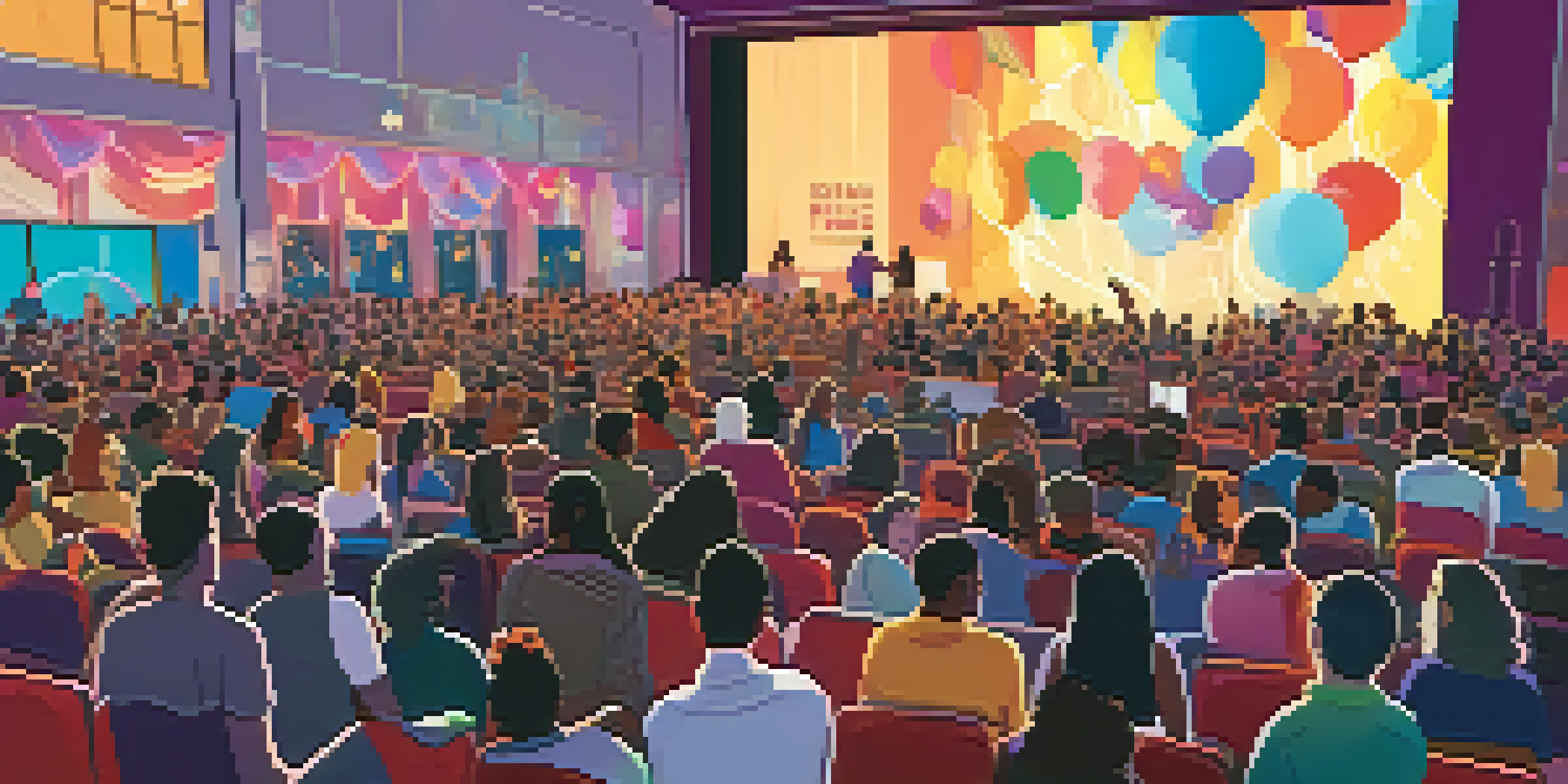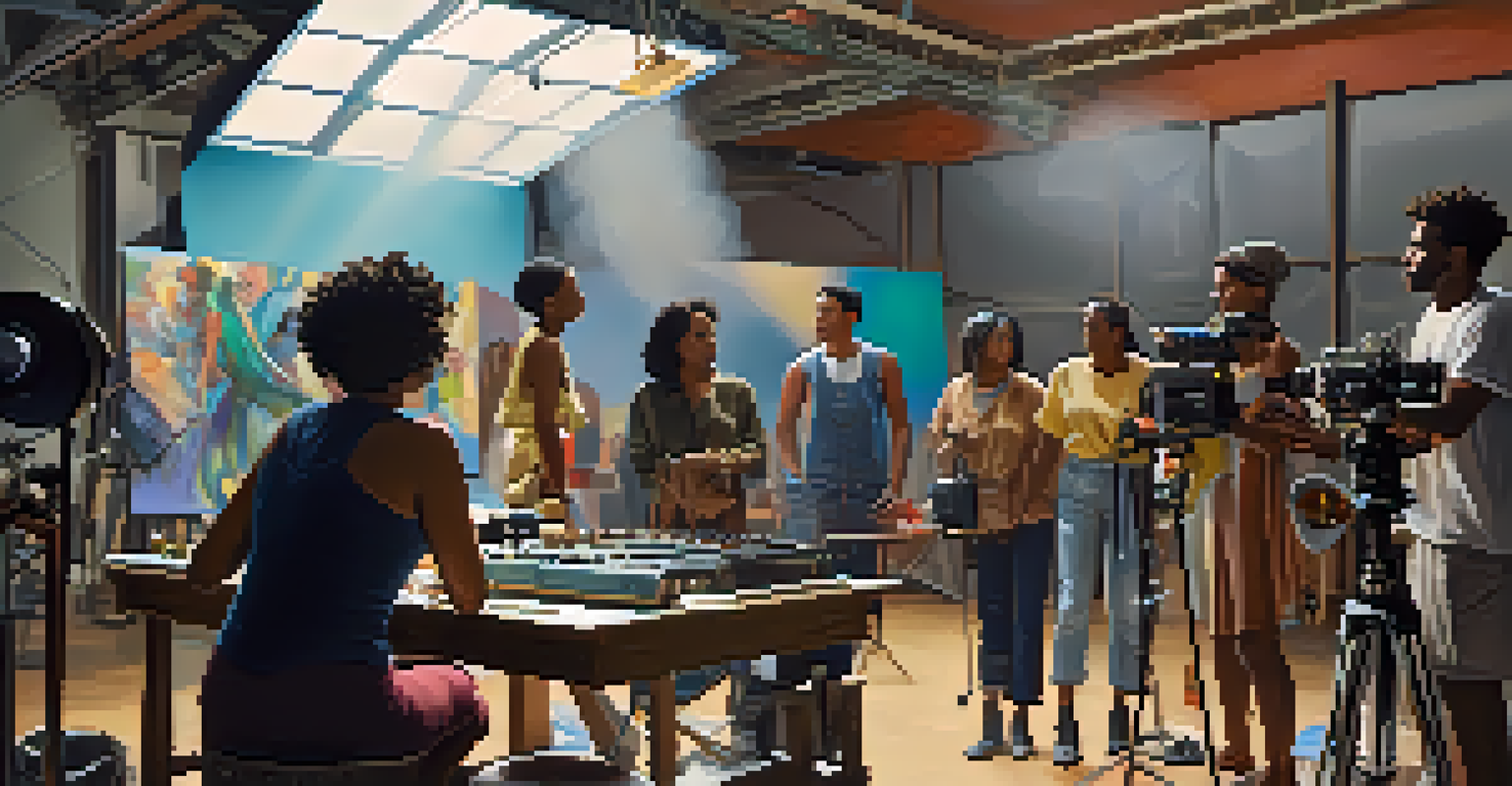The Rise of LGBTQ+ Representation in Film: A New Era

The Historical Context of LGBTQ+ Representation in Film
For much of cinema's history, LGBTQ+ characters were often relegated to the shadows or depicted in negative stereotypes. Films like 'The Boys in the Band' in the 1970s began to challenge these norms but were still limited in scope. By understanding this historical context, we can appreciate how far we've come in terms of visibility and representation.
Representation matters. It is vital for LGBTQ+ youth to see themselves reflected in the media they consume.
The shift began to accelerate in the late 20th century as societal attitudes towards LGBTQ+ individuals started to change. This change was reflected in films that began to portray LGBTQ+ lives more authentically, moving past caricatures. Iconic films such as 'Philadelphia' and 'Brokeback Mountain' opened the door for deeper narratives centered around LGBTQ+ experiences.
Today, we see a more nuanced portrayal of LGBTQ+ characters, thanks to a growing recognition of the importance of representation. This evolution not only enriches storytelling but also fosters empathy and understanding among audiences. As we reflect on this history, it’s clear that progress has been both hard-fought and transformative.
The Impact of Streaming Services on LGBTQ+ Visibility
The rise of streaming services like Netflix, Hulu, and Amazon Prime has significantly transformed how LGBTQ+ stories are told and consumed. These platforms often provide a space for diverse narratives that traditional studios may overlook. For example, series like 'Pose' and 'Sex Education' have brought LGBTQ+ experiences to the forefront, garnering significant attention.

Streaming services not only allow for a wider variety of stories but also give creators the freedom to explore complex characters without the constraints of a traditional film structure. This has resulted in richer storytelling that resonates with audiences. Viewers can now find authentic representations of LGBTQ+ lives, inviting them to engage with different perspectives.
LGBTQ+ Visibility Has Evolved
Over the decades, representation of LGBTQ+ characters in film has transitioned from negative stereotypes to more authentic and nuanced portrayals.
Moreover, the global reach of these platforms amplifies LGBTQ+ voices from various cultures, showcasing stories that might otherwise remain unheard. As audiences crave more inclusivity, streaming services are stepping up to meet this demand, paving the way for a brighter future in film and television.
Celebrating Milestones in LGBTQ+ Film
As we look at the past decade, numerous milestones have marked the achievements in LGBTQ+ film representation. For instance, the historic win of 'Moonlight' at the Oscars in 2017 for Best Picture was a watershed moment that celebrated a queer narrative at the highest level. Such moments serve as powerful reminders of the progress made within the industry.
The stories we tell reflect who we are and who we want to be; they shape our understanding of the world and ourselves.
Films like 'Call Me by Your Name' and 'The Handmaiden' have not only been critically acclaimed but have also introduced mainstream audiences to diverse LGBTQ+ experiences. These films emphasize the beauty and complexity of love, no matter the orientation. They highlight the importance of storytelling that resonates on a personal level for many viewers.
These milestones are not just about awards; they represent a broader acceptance and understanding of LGBTQ+ lives and stories. Each success builds momentum, encouraging more filmmakers to take creative risks and share stories that reflect the diversity of human experience. In celebrating these achievements, we inspire future generations of storytellers.
The Role of Filmmakers and Creators in Shaping Narratives
Filmmakers and creators play a crucial role in shaping how LGBTQ+ stories are told and perceived. The involvement of LGBTQ+ individuals in the filmmaking process—whether as writers, directors, or producers—ensures more authentic and relatable narratives. Their unique perspectives help bring depth and authenticity to the characters and stories presented on screen.
Collaborative efforts among diverse creators also lead to richer storytelling. For instance, projects like 'The L Word: Generation Q' showcase the importance of intersectionality in LGBTQ+ narratives, ensuring that various identities and experiences are represented. This collaborative spirit fosters an environment where new voices can emerge and thrive.
Streaming Services Amplify Voices
The rise of streaming platforms has provided a vital space for diverse LGBTQ+ narratives, allowing for deeper storytelling and broader accessibility.
Moreover, as audiences increasingly demand authenticity in representation, creators are stepping up to meet this challenge. This shift encourages a more inclusive approach to filmmaking, one that respects and celebrates the complexities of LGBTQ+ lives. The result is a vibrant tapestry of stories that resonate deeply with viewers.
The Importance of Intersectionality in LGBTQ+ Cinema
Intersectionality—the idea that various social identities intersect to create unique experiences—plays a vital role in LGBTQ+ cinema. Understanding that not all LGBTQ+ individuals share the same experiences is essential for creating more inclusive narratives. This recognition has led to more stories that reflect the diversity within the community, from race to socioeconomic status.
Films like 'Moonlight' and 'The Farewell' exemplify how intersectionality can enrich storytelling, offering layers of complexity to characters and their journeys. By emphasizing these different identities, filmmakers can craft narratives that resonate on multiple levels, inviting audiences to engage with the characters' struggles and triumphs in a deeper way.
As we continue to advocate for representation, it’s essential to highlight intersectional narratives that reflect the real world. This not only enriches the cinematic landscape but also empowers marginalized voices within the LGBTQ+ community. In doing so, filmmakers can create stories that truly reflect the beautiful complexity of human experience.
Audience Reception and Its Influence on Future Films
Audience reception plays a crucial role in the success of LGBTQ+ films, influencing future storytelling in the industry. Films that resonate with viewers often lead to greater demand for similar narratives, encouraging studios to invest in diverse projects. Positive reception of LGBTQ+ stories demonstrates to filmmakers that these narratives can attract broad audiences, not just niche markets.
The growing popularity of LGBTQ+ films also reflects a changing cultural landscape where acceptance and inclusivity are increasingly valued. When audiences celebrate films that authentically represent LGBTQ+ experiences, it sends a message to creators about the importance of these stories. This feedback loop inspires filmmakers to continue exploring LGBTQ+ narratives in innovative ways.
Intersectionality Enriches Narratives
Understanding intersectionality in LGBTQ+ cinema leads to more inclusive narratives that reflect the varied experiences within the community.
As audiences continue to engage with and support LGBTQ+ films, we can expect a wider range of stories that reflect the diversity of human experience. This influence drives the industry forward, fostering an environment where authentic representation can flourish. The future of LGBTQ+ cinema looks promising, thanks to the voices of both creators and audiences.
Looking Ahead: The Future of LGBTQ+ Representation in Film
As we look to the future, the evolution of LGBTQ+ representation in film appears bright. With more filmmakers advocating for authentic storytelling and audiences demanding diverse narratives, the industry is poised for continued growth. This positive trend signals an ongoing commitment to inclusivity that extends beyond mere tokenism.
Moreover, the increasing visibility of LGBTQ+ individuals in various roles within the film industry contributes to this momentum. From actors to executives, these voices will continue to shape the stories being told. As representation improves both in front of and behind the camera, we can expect a richer array of narratives that reflect the complexities of LGBTQ+ lives.

Ultimately, the rise of LGBTQ+ representation in film is not just about visibility; it’s about fostering understanding and empathy through storytelling. By embracing diversity and inclusivity, filmmakers can create a more vibrant cinematic landscape that resonates with audiences around the world. The journey toward authentic representation is ongoing, but each step forward brings us closer to a more inclusive future.